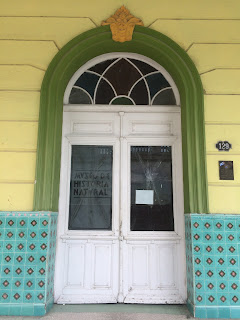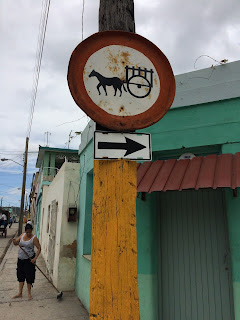The US Department of Treasury's website, question 11, describes the change: "OFAC has issued a general license that incorporates prior specific licensing policy and authorizes, subject to conditions, travel-related transactions and other transactions that are directly incident (sic) to people-to-people educational activities." Easy to understand, right? Um, no.
I looked up the Code of Federal Regulations, 31CFR §515.565(b), seeking greater enlightenment. Despite the fact that several friends recently returned from visits that sounded more like tourism than educational activities, I wanted to to make sure I wouldn't be hauled off to jail or, worse, interrogated in a bare room with one-way mirrors--in Spanish.
Satisfied that I would be honoring the letter as well as the spirit of the law, I flew to Holguin, a city in eastern Cuba that most Americans have never heard of. JetBlue handled the sticky details: medical insurance, visa at the airport in Florida, departure tax.
My reason for travel: meeting Cuban yoga practitioners, supporting the Yoga in Daily Life (YIDL) center in Holguin, and participating in the visit of YIDL's founder and leader, Parahams Swami Maheshwarananda. Many of you know of my involvement with this international, humanitarian organization that does much more than just teach yoga classes.
Some highlights of the week:
The City. Holguin is a small working-class city of down-to-earth, enterprising people. If you peer beyond the brightly painted buildings on the main square, grit and disrepair are standard. Money and jobs are scarce.
People line up by the dozens at the ice cream shop and the shoe shop. Regardless of economic circumstances, stylish shoes are important in Holguin.
Unlike the photos of classic cars in Havana at the other end of the country, transportation in Holguin is mainly on foot and by bicycle and horse.
There are dozens of bike taxis. And here we are traveling downtown in a horse taxi.
The Official Visit. In honor of Swami Maheshwarananda's visit, the local cultural center organized a superb program of entertainment and talks. Local musical groups and a children's chorus entertained our yoga master. In addition to Cuban songs, the children learned and sang YIDL spiritual songs--in the Sanskrit language--just for him! The children also performed a skit from the Ramayana, the ancient holy book of India.
The Yoga Center. In Holguin, the beautiful orange yoga center stands out in an otherwise decaying neighborhood.
Inside the center, dedicated yoga students and teachers greeted the master and sang spiritual songs. In return, he delivered spiritual lessons and lectured about being disciplined in our practice.
Outside the yoga center, our group planted a peace tree in the city's botanical garden and enjoyed a respite under a shade tree.
Twelve teacher trainees, who studied very hard for many months, took the difficult, 4-hour exam for certification as a YIDL teacher. I served as exam monitor, sweltering in the heat of a school classroom while they labored over the written test.
The Music. Besides the official program, we enjoyed various forms of music. We decided to forgo the nightclubs and cultural concerts, which all seemed to start after 11 pm. However, flamenco guitarist Jose, a close friend of our AirBnB hostess, regaled us in our kitchen.
On the street, I asked a strolling mariachi band to play for me. I gave them a huge tip, which caused genuine astonishment--possibly because Holguin is not a tourist town...?
In the town square, two young ladies waiting for the disco to open at 11 pm practiced their English with me and bought me roasted peanuts for about a dollar. Knowing the economic hardship of many residents, I offered to reimburse them, and they gratefully accepted.
The Tourist Experience. Though it wasn't my primary goal, I squeezed a little sightseeing into our yoga-centered week. Two of us hired an old red Ford for a hot, bumpy ride to the bleak, forgotten seaside town of Gibara, with its faded pastel buildings and dusty, worn natural history museum.
Next we slowly lurched down a rutted dirt road for 18 kilometers to the bleak, barren beach at Calentone, featuring a few rustic seaside shacks. A bit disappointing, though we did swim briefly. The Ford's cushy leather bench seats made the trip tolerable--despite the lack of air conditioning.
Note: More on our visit to Cuba is recorded in two articles I wrote for the international YIDL website here and here.














































No comments:
Post a Comment